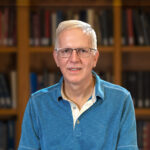
When we started the Congregational Leaders Fellowship, we were asked to bring our most sacred book to a meeting. This exercise caused me to think more deeply about my sacred books and what they mean to me. My rabbi recently did a d’var Torah (introduction to the weekly Torah portion) about the section called Terumah. This portion of the Torah describes in detail how the Tabernacle should be decorated and gives very specific details about dimensions and colors used for décor. This Torah portion also happens to be the same one that I read for my Bar Mitzvah exactly 50 years ago! I did not realize that it had been 50 years until I started thinking about the ICJS exercise.
As I am a student of art, I was inspired by both my rabbi’s talk and the 50th anniversary of my Bar Mitzvah to create an original oil painting displaying my most sacred books. I started the painting immediately on a very large canvas (24” x 36”)—I normally work on much smaller canvases (11” x 14”). The larger size already presented one challenge, but I also gave myself another challenge. I wanted to be true to the colors that are specified in the Torah, so I limited my palette to only crimson, blue, purple, white and black. Therefore, the color yellow (a primary color) had to be replaced with some other color (faint pink).
I photographed my three most sacred books:
- Tikkun—a book printed with a column of Hebrew with the vowels and a parallel column of Hebrew without the vowels,the way it is in the Torah.
- Chumash—Hebrew printed Torah text with English translation and interpretation
- Siddur—prayer book
I placed the books in the positions I wanted them with my tallit (ritual cloth hung around the neck with fringes at the bottom) draped around the books. Then, I PhotoShopped them into a background of the Sinai desert next to a succah (ritual hut used on the festival of Succot).
The initial “blocking in” of the painting went pretty quickly (a few weeks). The deep purple color of the mountains also was swiftly completed, although it required three coats; the color purple takes much longer to dry than other colors. I discovered that the blue I wanted was not the usual Ultramarine Blue used to paint the sky. The color Ultramarine Violet was much closer to the color I wanted (no one really knows the true color used in the Tabernacle or the Temple).
I hope that my painting will help people of other faiths to better understand the importance of books, learning, and ritual objects to Judaism and will also understand how individuals react differently to these sacred items. The Nazis understood the fundamental importance to Judaism of these sacred items, which is why they were destroyed first during Krystal Nacht (night of glass breaking and synagogue burning). I hope that my painting will inspire those of all faiths to learn more about each other’s ritual traditions, as we did in the Congregational Leaders Fellowship, and to become more effective interfaith leaders.
 Mark Schenerman is a member of Beth Israel Congregation and was a member of the 2022 ICJS Congregational Leaders Fellowship. Learn more about the ICJS Congregational Leaders programs here.
Mark Schenerman is a member of Beth Israel Congregation and was a member of the 2022 ICJS Congregational Leaders Fellowship. Learn more about the ICJS Congregational Leaders programs here.
Opinions expressed in blog posts by the ICJS Congregational Leader Fellows are solely the author’s. ICJS welcomes a diversity of opinions and perspectives.